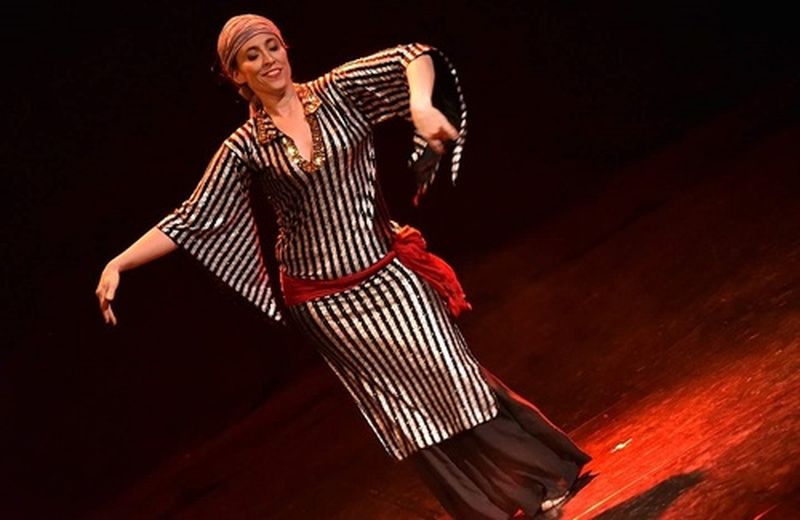Holistic Belly Dance: interview with Amalia Dell’Aquila
Amalia Dell’Aquila is a dance teacher with an extra gear: she combines the traditional belly dance with paths of inner growth and opening of the chakras. Let’s find out her method.

Amalia Dell’Aquila is a naturopath with a specialization in manual techniques and training at the SIMO school , a Middle Eastern and Tribal dance teacher (Gypsy Caravan format) and a researcher of the Sacred Feminine initiated as a Priestess in the Ara Tradition.
The scrupulous training in naturopathy and the path in the female Sacred have been going on for almost twenty years and have helped to shape her dance by infusing a holistic, ritual, sacred and well-being-oriented approach to women.
What is Holistic Belly Dance? How was it born?
Holistic Belly Dance is the English term I use within the larger cauldron called holistic dance . I like the term “cauldron” which well represents the creative and artistic bubbling that characterizes the dance I propose.
Middle Eastern dance , commonly known as “belly dance”, is the basic, ancestral and universal language that our body learns and remembers lesson after lesson.
On this basic language I add suggestions and connections from time to time that enrich the dance with meaning . Within Danza Holistic / Holistic Belly Dance it is therefore possible to follow different approaches that I have created in order to integrate the energy rebalancing techniques with dance.
The basic course of Holistic Belly Dance develops around the balancing techniques through dance , chakras and essential oils .
Starting from the basic format, you can continue through fascinating thematic insights : I propose “Raqs Chakra” ( which plays on the term Raqs Sharqi, “oriental dance”, transforming it into “Chakra dance”) which develops around the system of the Chakras in combination to the movements of Belly Dance.
Then there are other paths: in the “Dance of the Elements” the link between the 4 elements (Earth Air Fire Water) and oriental dance are explored; the “Dance of the 5 Wisdoms” celebrates the power of the Dakinis (dancing deities, women who fly in the sky according to Tibetan Buddhism) always through dance; “The Dance of the 5 Movements” deepens the dance through the “eyes” of traditional Chinese medicine and anchors the “Dance of the 7 gates” the most initiatory and profound path that develops around the figure of the sacred female.
Who is this dance aimed at and who is it suitable for?
It is aimed at women who want to dance in a conscious way , who are attentive to the holistic and sacred aspect of dance and are attracted both by the themes of energy rebalancing and by the attention to scrupulous and respectful of tradition technique.
How does it differ from other types of belly dance?
Danza Holistic / Holistic Belly Dance stands out for the completeness of the approach . Maximum attention is given to the technical aspects because dance is a language that must be mastered in order to create poetry with the body, therefore it is absolutely distinguished from those approaches that are not very attentive to the technical part (with the justification that only instinct is so important).
Even in its most ritual and sacred approach, great attention is given to technique , posture, respect for tradition as it is still a Middle Eastern dance with its precise rules and context.
It is also distinguished from other types of “holistic dance” – a very fashionable term lately – where the energetic elements (chakra, 4 elements, 5 movements, female sacred, etc …) are only touched upon without particular insights, unfortunately without particular training from part of those who hold the course.
What is the underlying philosophy?
Underlying holistic dance is the recognition of the unity of mind, body, spirit and the belief that our physical body and our subtle bodies influence each other by dancing together. A term that sums up the whole approach well: “non-improvised improvisation”
Improvisation (after technical preparation) is the basis of Middle Eastern dance and is desirable, but it must not be “improvised”, ie it must not be without head or tail or thrown in bulk, it must always be aware .
What are the benefits on the body and mind?
On the body, certainly flexibility : it helps the joints , the back , the internal organs (thanks also to the continuous massage through some of the typical movements of Middle Eastern dance), the posture and regulates the breath.
It certainly affects the mind through self-acceptance , greater confidence in one’s abilities, through the sense of relaxation and energetic activation (depending on the exercises performed), the increase in the sense of rhythm , proprioception.
It is important here to recognize that mind and body are not separate, every result on the body is reflected on the mind and vice versa .
How is a course structured?
Each type of course within Holistic Dance / Holistic Belly Dance is structured through a first part of warm -up – both static and danced -, part of technique, and cool-down.
The central heart of the practice will vary depending on the specific course with great differences: for example, on Raqs Chakra there will be a lot of attention on the individual movements of the Middle Eastern dance in relation to the chakras while in the “Dance of the 7 Gates” a lot of attention will be paid to aspects symbolic of the movement linked to the deities.






























+ There are no comments
Add yours